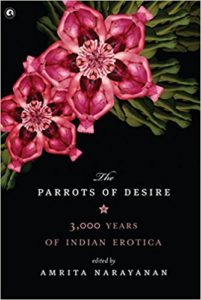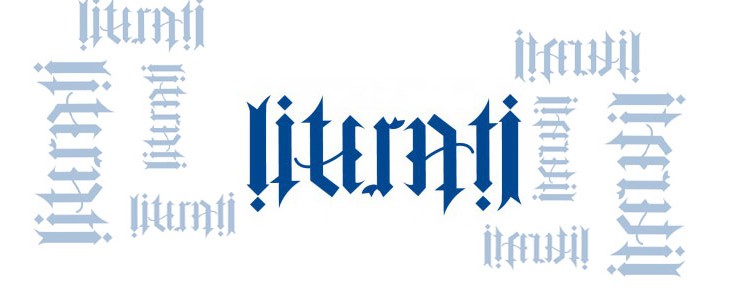The Erotic in the Indian Imagination
 Amrita Narayanan has edited Parrots of Desire: 3,000 Years of Indian Erotica , an anthology consisting of extracts from literature published in India over centuries. There are pieces from Rig Veda; the Tamil Sangam poets; Bhakti poets Antal and Mahadeviyakka, who describe women’s fantasies of men (whether human or godly); short stories by Kamala Das that have been out of print for decades; excerpts from the work of contemporary writers like Mridula Garg, Ginu Kamani, Tarun Tejpal, Deepti Kapoor, Sudhir Kakar et al. It is not as comprehensive in its survey as say the two volumes of Women Writing in India were and thus falls short of one’s expectations. Having said that Parrots of Desire is a start maybe to be added to later in a revised edition?
Amrita Narayanan has edited Parrots of Desire: 3,000 Years of Indian Erotica , an anthology consisting of extracts from literature published in India over centuries. There are pieces from Rig Veda; the Tamil Sangam poets; Bhakti poets Antal and Mahadeviyakka, who describe women’s fantasies of men (whether human or godly); short stories by Kamala Das that have been out of print for decades; excerpts from the work of contemporary writers like Mridula Garg, Ginu Kamani, Tarun Tejpal, Deepti Kapoor, Sudhir Kakar et al. It is not as comprehensive in its survey as say the two volumes of Women Writing in India were and thus falls short of one’s expectations. Having said that Parrots of Desire is a start maybe to be added to later in a revised edition?
Here is an extract from the opening pages of the well-written introduction published with permission. This section is “Erotic in the Indian Imagination”.
To read centuries of voices writing on the erotic is to become keenly aware of a deep argument that exists in the geography of the subcontinent, an argument between literary romantics—who embrace the erotic for the gloss it adds to life—and religious traditionalists[1]—who caution against the erotic, for its disorderly nature and potential to cause chaos. While romantic and traditionalist voices are unanimous in their belief that the erotic holds an extraordinary power and attraction for human beings, each does something very different with that belief. Romantics are erotically positive: they believe life is made worthwhile by its erotic aspects, that the best life is one in which our understanding and awareness of the erotic are maximally enhanced. Traditionalists, on the other hand, are erotically anxious: they believe that a worthwhile life is one in which the four goals of life[2] are in balance; they do not favour the promotion of the erotic, worrying that if not tightly controlled, the erotic could undermine the other three goals of life. Aficionados of the romantic project used the arts as a vehicle of articulation; their literature, music, drama, even grammar, was thought to be imbued with the erotic and capable of enhancing our understanding of the erotic. Traditionalists used both religious writing and the social contract to articulate the dangers of the erotic, believing that the erotic must be kept on the sidelines, aside from its necessary use as a vehicle for reproduction. Romantics believe that coupling is a central life force, and they appreciate the energy that comes from all couplings, whether man-woman, woman-woman, men who identify as women (and are fantasizing about male gods), or (wo)men with God. Traditionalists believe in the notion of an ‘ideal couple’: heterosexually and monogamously married, with children and extended family in the foreground and a willingness and ability to keep the erotic in the background.
To further understand the argument between traditionalists and romantics, consider a brief history of the time that traditionalism and romanticism have held sway. The purview of this anthology begins about 1000 BCE in ancient India. For the first 800 years or so of this time period, that is, beginning with the Vedas, traditionalist sentiments prevail. During this time, the destabilizing dangers of the erotic are far better articulated in the literature than are its pleasures. From the Vedas onwards, traditionalist literature, which is largely in the form of religious texts, is squarely articulate on the need to manage the destablizing potential of the erotic. Beginning in 200 BCE, however, and continuing for several centuries, literary voices sang the glories of the erotic and their dedication to it—in Tamil, Sanskrit, and Maharashtrian Prakrit. From the second to the sixth century, an Indian literary-erotic-nature idiom was spelt out from Tamil Nadu to Maharashtra and up to Madhya Pradesh. Here the poets embraced the erotic along with its problems, accepting that though the erotic often brought anger, grief and shame, it was still worth embracing for its pleasures. During this medieval period emerged the Tamil Sangam poets and the Maharashtrian Prakrit Gatha Saptasati, the prose and poetry of Kalidasa and Bhartrihari, as well as the Kama Sutra itself. After this golden age of the Romantics, puritanism once again holds sway and the next major erotic work—at least the one that has survived—is the collection of romantic poems known as the Amarusataka, written in Sanskrit in the seventh or eighth century and attributed to King Amaru of Kashmir. From the eighth century onwards there is again a long period in which very few important works have survived, the next set being from the Bhakti poets who compose discontinuously from the ninth to the fifteenth centuries in praise of erotic love with God himself. The fact that Bhakti poets praise erotic love only in language that involves a deity suggests that this was considered the most elegant and refined expression of romanticism at that time. Alternatively, perhaps, the social climate—which by this time included both Hindu and Muslim puritans—did not support an articulation of a more explicit person-to-person erotic love. The taboos on self-expression of erotic love might have impinged particularly on women poets and the re-direction of this love to the divine might have spared them the censorship that might have otherwise been forthcoming. Another way of thinking about it is that, dispirited with the limitations of romantic love between humans, some of these poets were able to find a more elevated idiom with the gods.
Following the Bhakti period, the proliferation of the Urdu language and the culture of refinement associated with Islamic courtly love played an important pro-romantic influence; but as the Hindu and Muslim puritans were joined by the British puritans in the seventeenth century, one has the sense that romanticism was very much in the dark ages. Nevertheless, important works continued to emerge in a more scattered fashion. Amongst these individual works are those written by courtesans, such as the Telugu Radhika Santawanam (The Appeasement of Radhika) by Muddupalani, in the eighteenth century. Another is the erotic proponent of the Lucknow school of poetry, Qalandar Bakhsh Jur’at, known for his bawdy yet spiritual imaginings of women in sexual union. As the reader advances towards and past the twentieth century, individual writers offer an exploration of contemporary erotic problems alternating with the past. Contemporary Indian writers who match and build on the efforts of their ancestors write in, among other languages, English, Tamil and Malayalam, and continue to shed profound light on the erotic. In this anthology the contemporary writers I have chosen include those who have made a searing commentary on the relationship between kama and society: Perumal Murugan, Kamala Das; those whose reverential treatment of the erotic couple recalls the glorious medieval period: Pritish Nandy, K. Satchidanandan, Tarun Tejpal; writers like Manto and Ambai whose erotic-nostalgic writings make us feel lustful and tender at once; modern Bhakti poets like Arundhathi Subramaniam and Kala Krishnan Ramesh; and those who have treated in great depth the extraordinary conflicts that the erotic poses for an individual life: here found in the works of Mridula Garg, Deepti Kapoor and Ginu Kamani
[1]I chose the word traditionalist and not puritan because of the historical origins of puritanism that are not pertinent to India. However I thought it worth mentioning that the traditionalist argument is close in nature to the puritan argument. Here puritan is used in the sense of against pleasure, see for example, H. L. Mencken, who sardonically defined Puritanism as ‘the haunting fear that someone, somewhere may be happy’.
[2]The four aims of life (purusharthas): artha (wealth), kama (desire), dharma (duty) and moksha (salvation from the cycle of life and death).
Amrita Narayanan ( ed.) Parrots of Desire: 3,000 Years of Indian Erotica Aleph Book Company, New Delhi, 2017. Hb. pp. 304
8 Sept 2017




